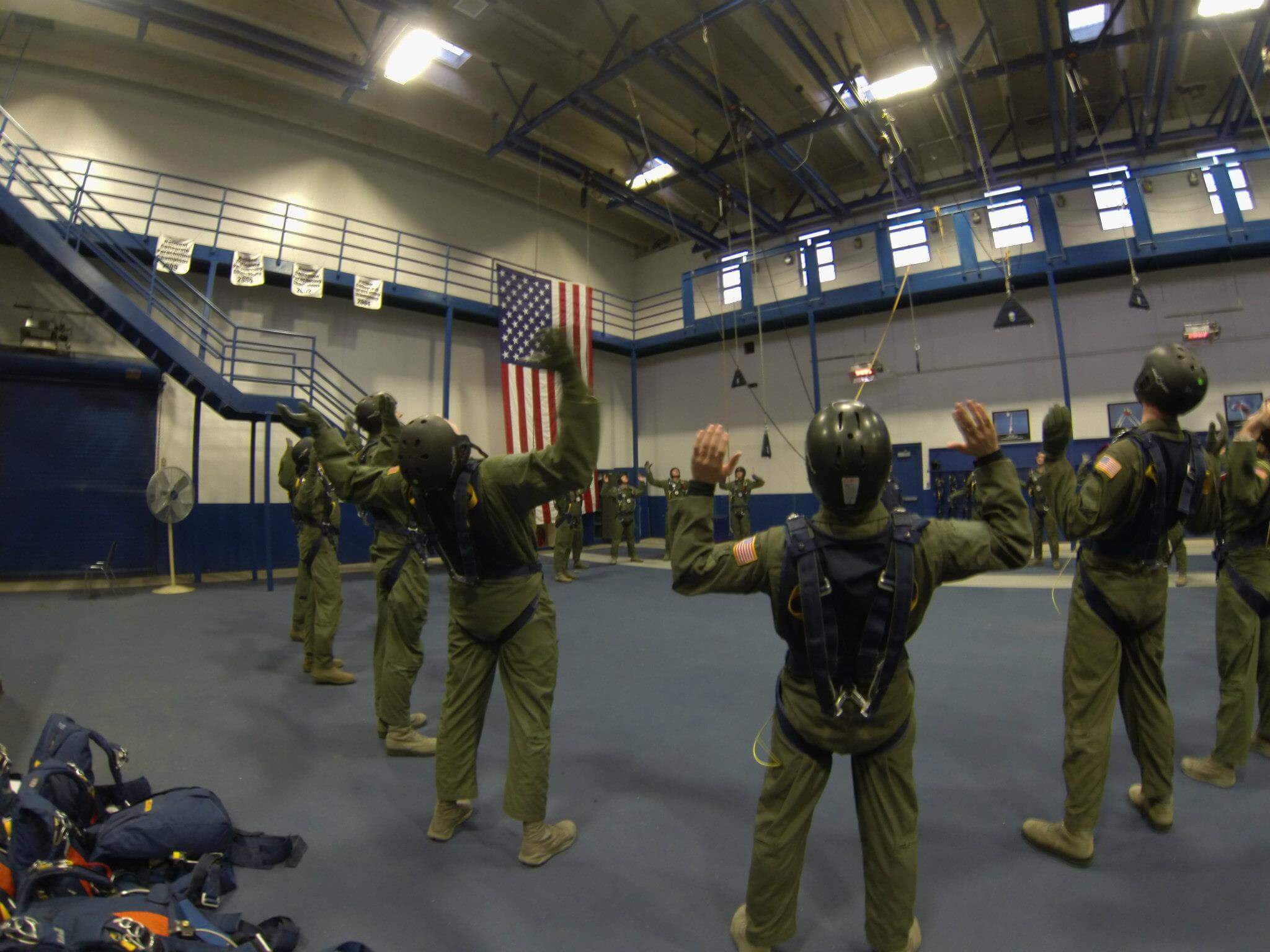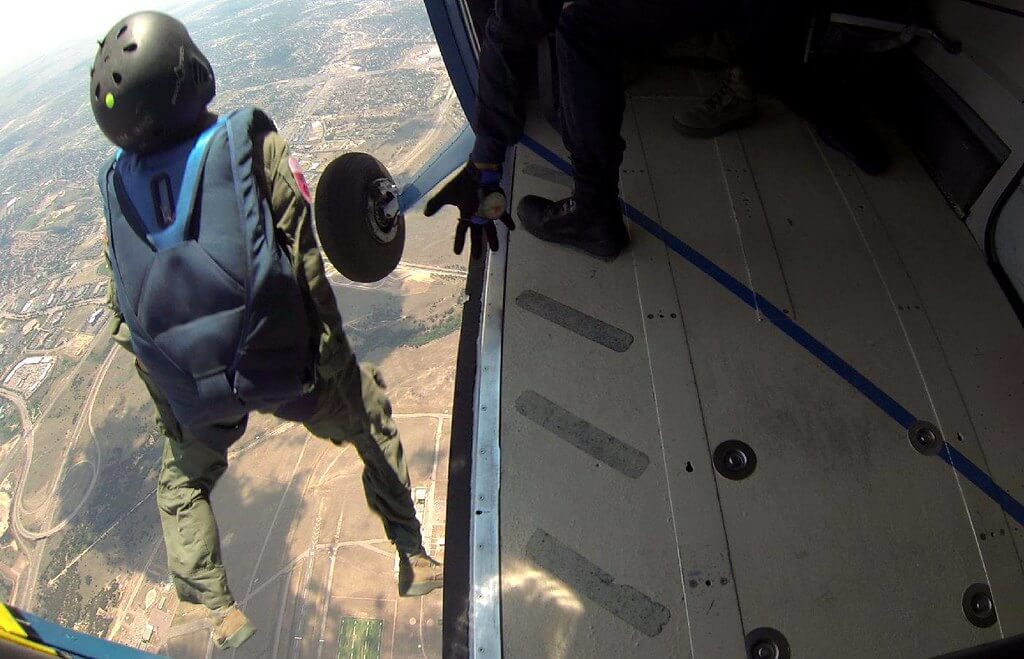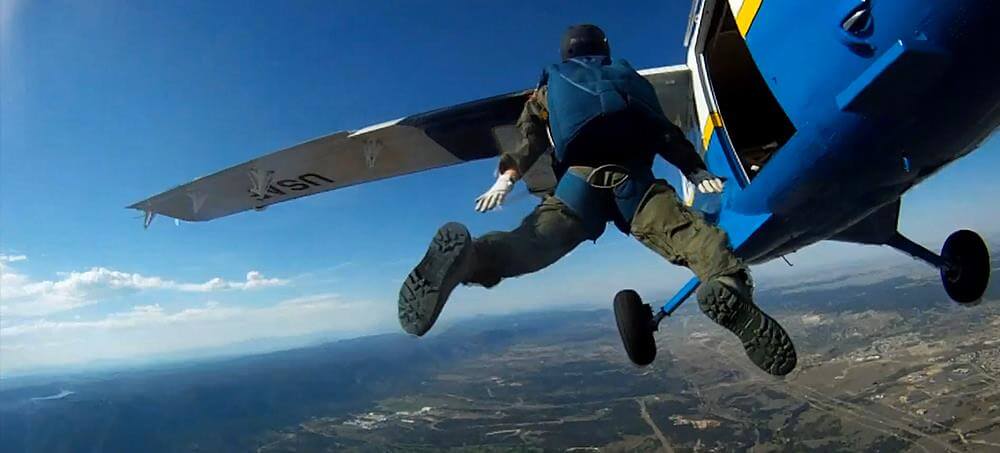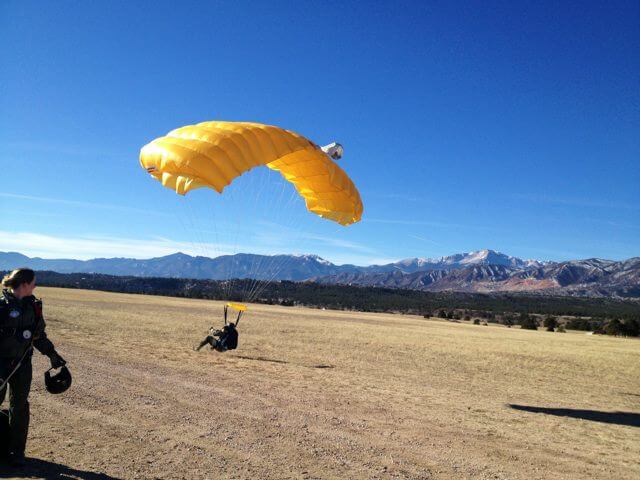AF Academy cadets teach their vice superintendent how to freefall

Third from right: Col. Houston Cantwell, vice superintendent of the U.S. Air Force Academy, poses for a photograph at the U.S. Air Force Academy with a cadet instructor (fifth from right) and his Airmanship 490 cadet classmates, July 2019. (All photos courtesy of the 98th Flying Training Squadron)
Commentary by Col. Houston Cantwell, U.S. Air Force Academy vice superintendent, July 10, 2019
U.S. AIR FORCE ACADEMY, Colo. — “Stand in the door!”
Never before had four words caused such extreme personal anxiety.
Circling above the Air Force Academy in the back of our trusty Twin Otter aircraft at 4,500 feet, I sat shoulder-to-shoulder in nervous anticipation with seven cadets. A warmer day than usual, sweat covered our faces. Maybe nerves were a factor? We wore helmets, goggles, flight suits, gloves and boots. And of course, a meticulously-packed parachute fit snugly on our backs. This would be our first jump.
Several cadet instructors looked over our equipment for proper fit and function. These checks took on extra significance, as the Academy is home to the only skydiving program requiring a “solo” first jump. We had just completed more than three days of intense ground training, including emergency procedures, wind tunnel, under-canopy procedures and parachute-landing falls. But lingering questions remained: “Was it enough?” “Would our parachutes function properly?” “Would we maintain a stable body position or spin wildly out of control?”
As the Academy’s vice superintendent, I was the first of my 70 classmates about to answer these questions. Like many, I considered acting like a sane person and remaining in the aircraft, but decided that being the laughing stock of the cadet wing was far worse than risking my life and hurling myself toward the Earth with a piece of nylon tied to my back—pride sucks.
Our 21-year old instructor, Cadet Ben Martin, raised the aircraft’s side door and slid it toward the ceiling. Over the engine noise and wind, I followed his directive, “Stand…in…the door!” I stood, grabbed the bar above the large opening in the side of the plane, placed my foot along the edge and forced my head into the slipstream. As if watching the ground move beneath us wasn’t sobering enough, the 80-mph blast of wind caused an additional adrenaline rush. With my heart beating wildly out of my chest, I was cleared to jump. All I had to do was let go of the bar and side-step into the wind. Fighting every instinct to hold onto that airplane, I let go.
During the next few days, my classmates and I completed our remaining jumps, jumping five times to earn our military “jump wings.” Honestly, each jump brought nearly as much anxiety and emotion as the first, but the real lessons occurred on the ground with the cadets.
I attended the University of Virginia and earned my commission through ROTC, so I never had the opportunity to jump as a cadet. I enrolled in Freefall to better understand how the Academy prepares cadets for service in the Air Force.
Freefall forces cadets to face new challenges and push past their personal boundaries. It provides intense and effective training that positions them for success. At times, we were overwhelmed by the amount of information we were required to memorize. My classmates and I wondered if we would ever master such a wide span of material. In this program, rote memorization is insufficient. Students must memorize and properly apply the information under stressful conditions. These skills serve cadets well as they pursue operational flying careers in the Air Force.
Frankly, the leadership exhibited by the cadet instructor cadre stood-out as the cornerstone to program success. This summer, Cadet Steve Rumsey leads roughly 50 cadet instructors. These upper-class cadets serve on the Academy’s skydiving team, “Wings of Blue,” and regularly perform demonstrations and compete (and often win) in national competitions throughout the year. During the summer, however, their focus is on training more than 450 students.
These instructors brought unparalleled professionalism and positive energy that directly resulted in student success. They led us through physical training, academics and, most importantly, demonstrated mastery of all freefall procedures. The cadet instructors ensured each student met the standards of performance. They checked our parachutes for even the most-minute discrepancies; marshaled us onto the aircraft; surveyed the drop zone; and ensured maximum levels of safety during freefall operations. Following each jump, an instructor reviewed video of every student’s performance, ensuring we remained safe and met standards. If required, they directed additional training and in extreme cases, might recommend removal from the program. Through hands-on experience, these young leaders are refining leadership skills that will serve them well throughout their Air Force careers. I couldn’t have been more impressed with the esprit de corps, meticulous attention to detail and preeminent level of professionalism demonstrated by these cadets.
The most prevalent question I’ve been asked following this experience is, “Would you do it again?” and to that I answer with a wholehearted, “Hell yes!” — but probably not for the reasons you might expect. Having just notched my 47th birthday, my adrenaline-seeking days have long passed. The real value in my experience was found in my cadet classmates and highly-capable cadet instructors. We conquered our fears and learned sky-diving procedures at a pace you won’t find anywhere else in the world.
Certainly, my blood pressure will peak the next time I hear anyone yell “Stand in the door!” but I’ll remember the talented cadets I was privileged to train with and learn from. I’m proud to join the ranks of the more-than 32,000 graduates of this Academy program, but I’m most proud of our cadets — our future Air Force leaders who demonstrated grit and determination and led us to success. Freefall!
Airmanship 490 photos

Our training started in the “classroom”…

…But soon took us to …

…higher altitudes.

We always landed safely, thanks to our incredible cadet instructors.
[Author’s note: Though this commentary is focused on our talented cadets, the 29 permanent party officers, noncommissioned officers and civilian parachute riggers assigned to the 98th Flying Training Squadron remain essential to our Airmanship Programs’ success and should not be overlooked.]